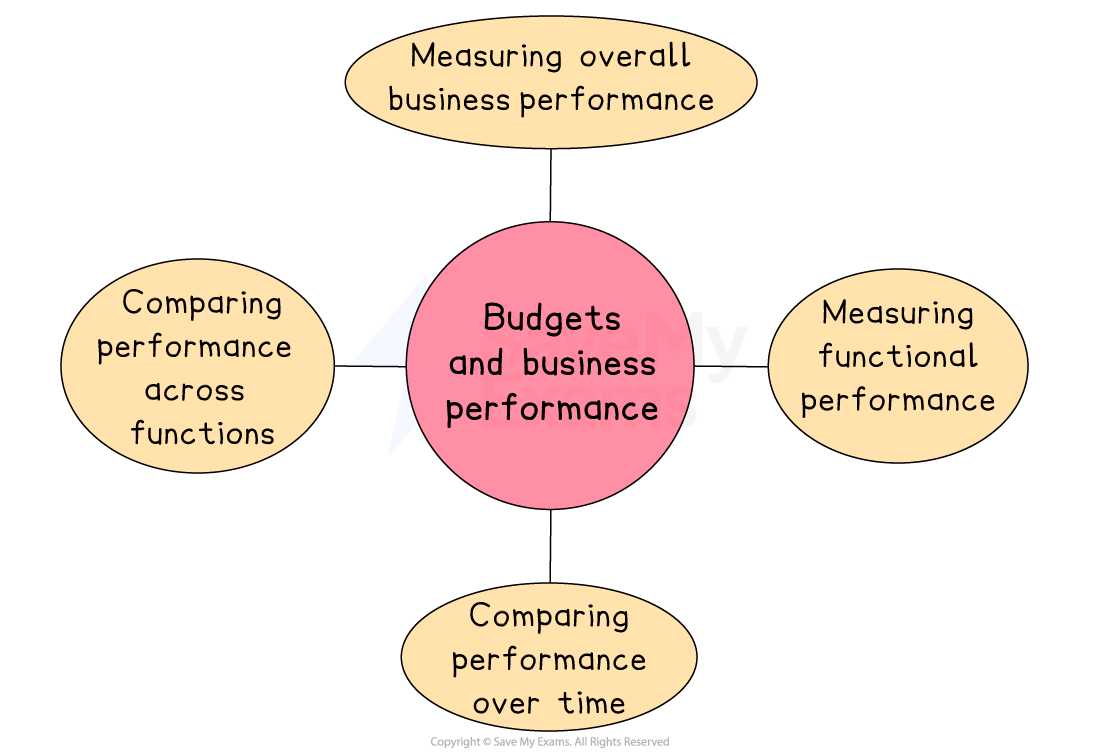Using Budgets Effectively (Cambridge (CIE) A Level Business): Revision Note
Exam code: 9609
An introduction to budgets
A budget is a financial plan that a business (or department in the business) sets regarding costs and revenue
The budget is usually closely aligned with the business objectives

Measuring performance with budgets
Measuring overall business performance
Budgets allow managers to assess how well the whole business is performing
Compare actual income and expenses with budgeted figures to identify profit levels, cost control, or overspending
Helps judge if the business is meeting its financial goals, such as revenue targets or profit margins
Variances help explain good or poor performance
Measuring functional performance
Each function, e.g. marketing, operations, HR, usually has its own budget
Comparing actual department spending and results with the budget shows how well each area is performing
Helps hold managers accountable for cost control and meeting targets
Encourages efficient use of resources within each function
Comparing performance over time
Budgets help track performance year-on-year or month-on-month
Businesses can spot trends, such as rising costs or improving efficiency
Helps with long-term planning and forecasting
Comparing performance across functions
Budgets help compare different departments at the same time, even if their roles are different
This supports fair decision-making on things like bonuses, promotions or extra funding
Types of budgets
1. Incremental budgets
An incremental budget is based on last year’s figures, with small adjustments made to reflect expected changes
Changes could include inflation, wage rises or modest increases in sales and costs
Evaluating the use of incremental budgets
Advantages | Disadvantages |
|---|---|
|
|
|
|
2. Flexible budgets
A flexible budget is adjusted depending on the level of output or sales
Instead of using one fixed figure, it shows what income and expenses should look like at different levels of activity
Evaluating the use of flexible budgets
Advantages | Disadvantages |
|---|---|
|
|
|
|
3. Zero budgeting
Zero budgeting is when every department or manager must justify all spending
Rather than using the previous year’s budget as a starting point, each cost must be reviewed and approved individually
Evaluating the use of zero budgeting
Advantages | Disadvantages |
|---|---|
|
|
|
|
The use of budgets
Budgets can play an important role in the day-to-day management of a business
They help with planning, decision-making, control, and monitoring of non-financial performance
Ways budgets are used
Allocating resources
Budgets help businesses decide where money and resources should be focused
Each department receives funding based on its needs and priorities, ensuring efficient use
Control within a business
Budgets set clear financial limits to help prevent overspending
Managers are accountable for staying within their budget, which improves discipline and control
Monitoring non-financial performance
Budgets can track spending on non-financial goals like customer service, training, or sustainability
This ensures resources support wider business objectives
Variances
Once budgets have been set, managers carry out variance analysis to compare actual performance to the targets set in the budget
A budget variance is a difference between the figure budgeted and the actual figure achieved by the end of the budgetary period
Variance analysis seeks to determine the reasons for the differences between the actual figures and the budgeted figures
Types of variance
Favourable (F) | Adverse (A) |
|---|---|
|
|
Calculating and interpreting variances
A budget variance is calculated by subtracting the budgeted figure from the actual figure
Worked Example
Selected financial information for Barwicks PLC (2024)
| £m |
|---|---|
Budgeted sales revenue | 12,460 |
Actual sales revenue | 13,718 |
Budgeted total costs | 8,420 |
Actual total costs | 10,627 |
Using the data, calculate the total profit variance for Barwicks PLC in 2024. You are advised to show your working.
(4)
Step 1: Calculate budgeted profit for 2024
(1)
Step 2: Calculate actual profit for 2024
(1)
Step 3: Subtract budgeted profit from the actual profit for 2024
(1)
Step 4: Identify the nature of the variance
In this case, the variance is adverse because the actual profit for 2024 is lower than the budgeted profit for the year
The correct answer is £949 A (1)
Evaluating budgets
Budgets can be useful management tools because they help maintain financial control by monitoring income and expenditure
This allows managers to spot potential overspending or cash flow problems early
Budgets also help measure performance by setting financial targets that can be compared with actual results
This makes it easier to assess how well a department or the whole business is performing and whether corrective action is needed.
However, budgets are based on forecasts and assumptions, which means managers make inappropriate decisions if market conditions change or if estimates are wrong
Strict budgets may reduce flexibility
Managers may feel restricted and unable to respond quickly to unexpected opportunities or urgent problems if they are required to stick closely to a fixed spending plan
Advantages and disadvantages of budgeting
Advantages | Examples |
|---|---|
|
|
|
|
|
|

Unlock more, it's free!
Did this page help you?